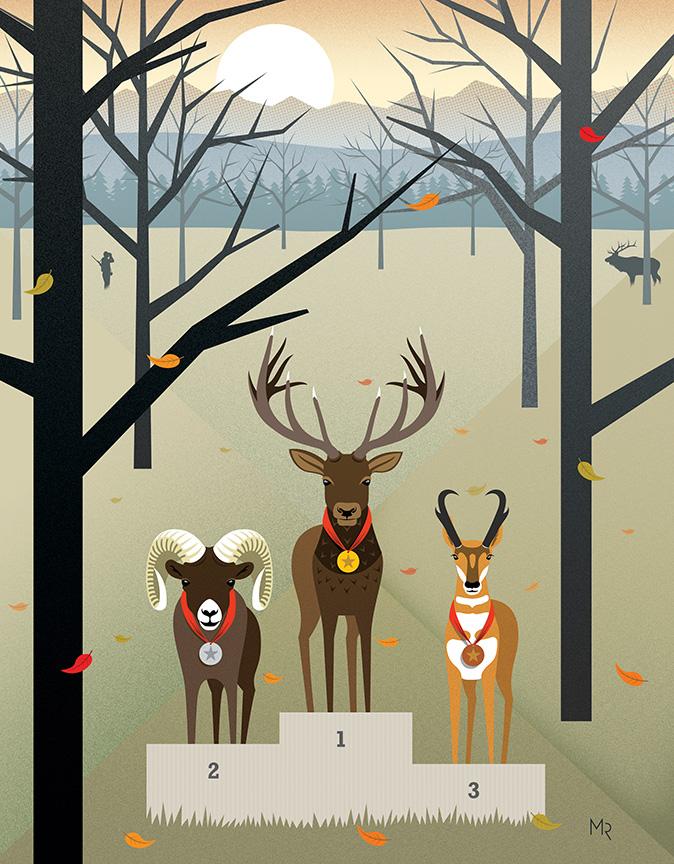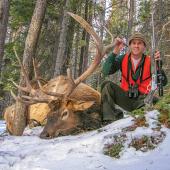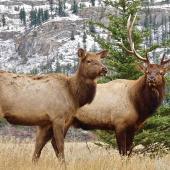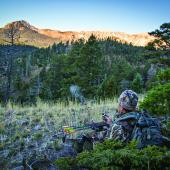The Measure of a Hunt
Ethics in sport.
Surely elk-hunting is good for elk. Otherwise we’d have to defend killing as sport.
Climbing in the dark against icy wind, after a tiring day that had shown me no elk, I saw antler tips before the bull saw me. Dodging through twisted pines, I got an offhand shot at 60 yards. The bullet landed well. That five-point yielded many pounds of meat, if not record-book bone or much adulation. Though it also brought me great satisfaction; only the two men who helped pack it out have seen that bull. I don’t bring it up in conversation. There’s no photo of me with the elk, no cell phone image of the elk.
I shot the animal for reasons that, decades after they made sense to me, still defy articulation.
Early on, hunting provided food, plus material for clothing, tools, weapons, and shelter. The best hunter got the most animals—plus admiration from women and his peers. As the need for subsistence hunting faded, able hunters maintained their status. During westward expansion in the U.S., settlement, market gunning, and deadlier firearms changed landscapes and depleted game stocks. By the end of the 19th century, hunters had started a crusade to conserve wildlife. A swelling urban populace later called for its total protection. Conflict between conservation (wise use) and preservation (no use) would intensify.
But you probably know that—and that wildlife over much of the U.S. flourished on the heels of the Depression. Predator control, easy winters, shifts in grazing regimes, restrictive hunting regulations from nascent game agencies, and the war-time exodus of young men combined with other factors to hike game numbers in the West. Since the ’20s, elk had been transplanted from Yellowstone’s herd to most suitable ranges fringing the Rockies. Second-growth in the wake of Idaho’s cataclysmic 1910 fires and Oregon’s later Tillamook Burn, with other habitat changes, improved the lot of deer and elk. Returning GIs didn’t have to push their sedans very far up primitive tracks to find big bucks and bulls. Hunters with pack stock and surplus Willys Jeeps probed backcountry alive with game. In the East, whitetail deer adapted so well to cropland and suburbia that their populations would quadruple over the next 30 years.
This cornucopia of game shifted the focus of hunters. Relieved by post-war prosperity of the need for venison in the freezer, hunters sought outstanding specimens, displaying them as trophies.
A preoccupation with trophy score followed. Some years back, meeting a client on the eve of an elk hunt, I extended my hand. Instead of shaking it, he pulled from his pocket a photograph of a dead elk. “That’s a 360 bull,” he declared. “I want one bigger.” Another whispered, as we crept within range of a stunning herd bull, “Will he make book or not?” Yet another, approaching a bull he’d just killed, groused: “Those G3s are awfully short.” For these men, the value of an elk—indeed, of the hunt—lay between hash marks on a flexible tape. Place, people, and effort mattered not. Absent too: any blush of sport. But hunting is sport. Isn’t it?
Many hunters still have no interest in trophies, and most who do will never put an animal in the record books. Still, the status big trophies confer in hunting circles, the emphasis on trophies in hunting publications and videos, and the growing number of outfitters offering trips for trophy game confirm that hunting is no longer just weekend recreation. The classic contest between hunter and quarry is giving way to competition among hunters for recognition. Televised kills by sponsored “pro staff” shooters have redefined success, though their exploits get many assists, often on property inaccessible to the public. For youngsters weaned on such images, the processes of scouting, then searching for a wary animal on foot, quickly lose appeal if they don’t produce big antlers.
To be fair, some hunters set high trophy standards for the pure love of the challenge. Some even keep a modest profile after taking outsize game. A handful of videos hew to this ethic, in places and under conditions that don’t ensure a kill. Still, when it does occur on-screen, death appears as more than climax. It almost always overshadows, in tape time and emphasis, the effort of hunting.
Okay. That’s what sells. The market determines show content. If viewers didn’t want to see bullet impacts and lifeless animals rolling down mountainsides and high-scoring heads in Bubba’s paws, such images would be edited out. They’ve proliferated. As success is ever more tightly bound to the size and numbers of animals killed, hunters craving status adopt those measures. Indeed, the definition of “trophy” has broadened to include awards for taking series of trophy animals of a given type. The “grand slam” of wild sheep has, arguably, diminished the significance of killing one ram. In some circles, unless you have all four, you’re still an aspiring sheep hunter. That term has gone international; so too European medals. You can kill gold-medal game en route to a trophy saluting a slam on the south wall of your trophy room.
Competition begs a level playing field. Of course, in hunting none exists. Forest, mountain, and veldt yield their bounty capriciously. Muddying the definition of trophy is the contention that any animal fairly hunted should qualify, a concession to the great unwashed who hunt where pressure is so great or game genetics so ordered that record-book animals are essentially absent.
Now, groups that celebrate trophy hunting and sustain competition among hunters deliver huge benefits to wildlife and its habitat, and to work-a-day hunters. Beyond legislation and direct contributions to conservation projects, these clubs support markets in exceptional hunting and the places and people producing it. Value added to hunting or to trophy animals encourages the protection and enhancement of habitat that otherwise might be grazed bare or slated for development. Wildlife agencies respond to these markets too, with management that hikes numbers of mature males. Age and sex ratios of game in areas so tended usually improve, favoring the fortunes of both herds and hunters.
Competition that inspires trophy hunters is part of what defines them as sportsmen.
I first fired rifles in bull’s-eye matches, not at game. The purpose in any match was clear: winning. To win, you had to beat other shooters who followed the same rules and who fought wind, mirage, and pulse bounce as you did, over the same distance, at the same targets. Shooters who consistently topped the scoreboard were the best shooters.
Hunting has little in common with competitive shooting—or tennis or chess. Hunting doesn’t impose the same strictures or afford the same opportunities to everyone. In its crudest form, it is a pinball game, the hunter launching briefly into the wild, optimistic he’ll bump into something to shoot. Disciplined hunters can tilt the table in their favor, with physical conditioning, scouting, and other prep. But some factors can’t be controlled. Luck has more influence now, as limited-entry draws replace over-the-counter tags. Of course, luck carries a certain charm. It’s why a beginner can bag the biggest buck where skilled hunters fail. It’s why we of modest means and limited time maintain bright hopes of one day killing a stupendous buck or bull.
The cost of hunting some species has effectively priced out many hunters otherwise up to the challenge. In my youth, local deer hunters traveled north every few years to hunt moose. These days, provincial outfitter requirements and fees have narrowed the field. By most standards, North American sheep and brown-bear hunts are now prerogatives of the privileged. No hunter in the 1950s could have fathomed Montana charging $1,000 for a general elk tag, the current rate for non-residents. Many guided trips into the West’s best elk units top ten grand.
At high levels of competition, many sports are expensive. Horse-racing, sailing, and Formula One auto-racing come to mind. Cost alone doesn’t strike hunting from a definition of sport. But hunting is not like competitive ball sports, or in fact any activity that rewards superior performance. To excel, you must measure yourself against others. Because conditions and assists, natural and otherwise, vary from hunt to hunt, sport describes hunting only in a broad sense, as backcountry skiing is sport. The term “sportsman” has proven as hard to nail down.
“You know,” confided one Africa professional hunter over a campfire, “we get lots of collectors here, but few hunters. Collectors care about how many animals they shoot, what the horns tape, how they compare with game shot by other clients. Hunters care about the chase.” I’ve observed the same. A focus on celebrity runs cross-grain to traditional views of fair chase. An animal hard-earned and fairly shot bumps my pulse more than would any record-book entry taken without effort. But I’m not everyone.
Some seasons back, I acceded to local hunting custom and sat, with a friend, to wait for deer. A beautiful whitetail ghosted in just after dawn. “May I photograph him?” whispered my pal. I nodded. The buck stayed for many frames, then ambled toward cover. My amigo lowered his Nikon. “You’d best take him now.” I chose instead to watch that deer fade into the brush, explaining later that killing it would have been anticlimactic. No effort, no reward. The photos were trophy enough.
Another time, hunting eland in Namibia, I chanced upon a kudu bigger than any I’d ever seen. It was a fair encounter. I declined the easy shot, figuring the animal was just too fine to kill incidentally.
A few seasons later, prowling the thorn with a double rifle, I shot a kudu with more modest horns. No hesitation. I was hunting kudu. At mid-day. With iron sights. Tough assignment, great reward.
Animals uninspiring as shoulder mounts can give good account of themselves in the field. Alas, you can’t hang on the wall challenges imposed by terrain and weather, or the skills, physical effort, and persistence tested on a hunt. Measures of antler, horn, and skull merely reflect a trophy’s biological status at time of death. Nothing of the hunt resides in taxidermy. Only the hunter who shot the beast sees beyond its reconstruction, to tension, decisions, an instant in time and a place suddenly silent. Elements of sport?
A pal once drew a bison tag, a coveted ticket to hunt a difficult place for truly wild bison. He chose to take his longbow. “Are you crazy?” screeched the local brethren. “That’s a license you’ll never get again!” Ignoring their advice to trade arrows for bullets, he hied off into the hills and arrowed a bison. That cow was no bigger than if she’d met a 30-caliber softpoint. But the hunt was more satisfying to this sportsman.
Another friend, who turned 70 recently, has hunted the same alpine basins for decades. I’ve been there with him, in t-shirt weather and when the snow lay thigh-deep. We’ve worked hard for mediocre bucks. His three boys grew up to know a mule deer hunt as a seven-mile hike, a spike camp, and oft-brutal conditions in steep places. They’ve not always taken game, but still thrill to the experience. Last October my friend found an outstanding deer and dropped it with his .30-’06. What satisfaction!
Not all youth can bear the deprivation of difficult hunts. Killing matters to the novice. No matter how compelling the argument that hunting doesn’t always end with a shot, beginners dread this question: “Did you get your buck?” It’s “your” as if every deer is appointed an encounter with a hunter destined to kill it. It’s “your” as if every hunter with a license deserves to kill a deer. It’s “your” as if leaving deer alive is dereliction of duty, or a failed exam in Woodsmanship 101.
I recall not wanting to talk about deer after my first hunts. Constrained to prowl heavily hunted woods, I didn’t see a branch-antlered whitetail for several seasons. Returning empty-handed was failure. After all, if you’re hunting deer, isn’t killing deer the object, a dead deer proof of success? Then people started asking why I hunted. Killing wasn’t the right answer, because I too seldom killed. Alternatives: hunting is a meat-gathering effort that doesn’t always succeed. It’s the result of a natural predatory bent. It’s tradition, with a grand history that makes it as much a study as an activity. And of course, hunting is conservation.
Even in those days, as the Vietnam War ramped up, it was fashionable to emphasize the aesthetic virtues of a day afield—mountain vistas, the intricate workings of nature. Hunting did bring me to lovely places. But they turned downright magical over a steaming carcass! “Hunters want to get game,” a long-time outfitter told me. “That’s why they hunt. If they tell you different, don’t believe them. The object of hunting has always been to get game. A hunter who loads his rifle puts his reputation as a predator on the line. Even if he doesn’t really like hunting, he’ll try to shoot something because people back home will judge him by his trophy. That’s why nice people who go hunting become so intolerable after a few days without luck.”
That view of hunting, credible if not universally true, can change as a hunter ages. Now, decades after my teenage bloodlust, I can return from hunts that afforded no shots—or having declined shots—without chafing. I still hunt hard, still feel the pulse pound during an approach, still delight in a shot well delivered. I’m hooked on the suspense, aware that if a kill were sure, there’d be no suspense. The shot is still a climax, no longer an imperative. I needn’t kill to have hunted. Shooting comes when, after enough effort, it seems the proper finish.
I use the meat. I’m mighty grateful for big antlers. The shot is still an intimate connection.
It is also exclusive. However widely shared the results of a hunt, no one can duplicate it or by antler score compare it with any other. No matter how many hunts in memory, none will ever be its equal. In that way, a hunt is the rarest form of sport.
But unlike competitive sport, a trophy room, or a dead animal, a hunt has no measure.
This essay originally appeared in Bugle, the magazine of the Rocky Mountain Elk Foundation.










